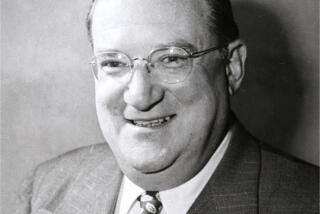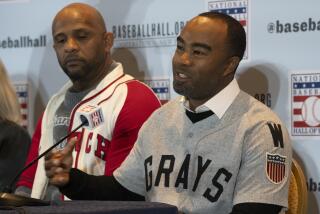Town Is in Danger of Losing Its Charm
- Share via
COOPERSTOWN, N.Y. — Holding on to the past, as one might endeavor to preserve a childhood memory, is commendable but impossible. Downtown Cooperstown, a village with one traffic light and flower boxes attached to the windowsills of gracious Victorian houses, fronted by impeccable lawns, has undergone sudden change.
It’s going “carni.” Coney Island has taken over. Commercialism rears its insatiable head and Main Street, which once offered old-fashioned store fronts, is in danger of heading for ruin. The warning signs are up.
How much longer will the charm of Cooperstown remain? It’s here where we’re told Abner Doubleday and barefooted farm boys played the first game of baseball and, even if it is a historical lie, as some researchers have suggested, the setting is ideal for accepting the fiction as some kind of poetic license for stretching the truth.
Cooperstown, as the cradle of baseball, might be mythical but is truly symbolic of a time 151 years ago when the grand American game was born. A visit to where baseball began is something of a spiritual experience. You are put in the proper frame as you walk the tree-shaded streets and view this special quality and pace of life.
But none of what has transpired of late around town is for the best. It can’t be defined as beneficial when Cooperstown is showing signs of losing its character. Aesthetically, it has been rocked on its heels. There’s shock.
Tourists and the “townies” agree. They don’t like it. Can something be done to put the brakes on the erosion of a memorable setting that author James Fenimore Cooper brought to the literary attention of the world in using these green hills and crystal waters as the backdrop for his wondrous adventures?
The natives are particularly upset. At last count, nine stores selling baseball cards, a modern phenomenon, are open for business. Some establishments erect tables on the sidewalk to showcase their wares, selling all types of souvenirs such as T-shirts, pictures, bats, caps and uniforms.
Barbara Landers, who operates the Short Stop Restaurant, which was founded by her grandfather, Salvatore Sapienza, in 1921 and given its present name in 1939, the year the Hall of Fame opened, shook her head in dismay and said, “Cooperstown is getting too big for itself. We might have to put a stop to it. The trend is upsetting to all of us who truly care about Cooperstown.”
A member of the Baltimore Orioles’ sales department, Lucy Kelly, recognizes what is taking place but insists Cooperstown retains an appeal all its own. “I still find it a quaint little town,” she said. “The Hall of Fame draws me and, of course, the striking beauty of the countryside.”
Dr. Michael Klein of Baltimore has been coming here every summer since 1977 to enjoy the tranquility and the history that abounds. Asked for a comparison, covering two decades, he answered, “It used to be an original. Now it’s getting like any other city. But I plan to keep coming back.”
Closer to the heart of the village is Marge Strait, who owns the Cooperstown Diner. She insists the “whole town is upset.” Can anything be done? “The town trustees held a meeting to discuss it. But you can’t lock the gate after the horse is out. Most of the change has happened in the last year.
“We have to do something. It’s getting trashy looking. Four new card shops have opened. How do you keep them out? The baseball memorabilia places, some of which pay the Hall of Fame players money for signing autographs, set up tables on the street and even erected tents on their property. It’s a shame.”
Cooperstown has a fight on its hands to recover the identity and protect the indigenous characteristics that made it so distinctive. It’ll survive, no doubt, but, hopefully, the scars that have been inflicted will be repaired.
More to Read
Sign up for our Book Club newsletter
Get the latest news, events and more from the Los Angeles Times Book Club, and help us get L.A. reading and talking.
You may occasionally receive promotional content from the Los Angeles Times.










